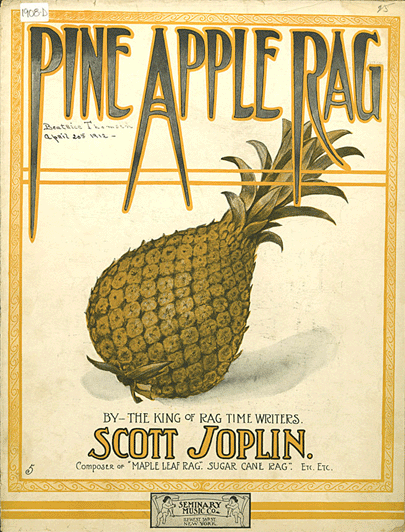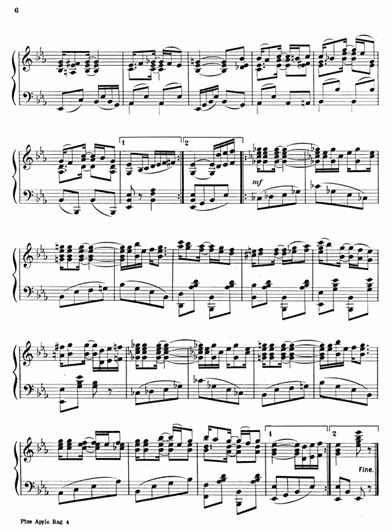27 - Important Distinctions between Five Kinds of Broken-Octave Bass Figures
by John Tennison — History of Boogie Woogie
What are the necessary and sufficient elements to constitute a broken-octave Boogie Woogie bass line? Some historians have erroneously referred to ANY broken octave bass line as a Boogie Woogie bass line. Yet, there are specific reasons why a broken octave bass is NOT sufficient in and of itself to create a Boogie Woogie feel. For example, broken octaves have been used in the keyboard music of Bach and other classical composers, and at least as early as 1908 in the Ragtime music of Scott Joplin. Although it only occurs for two measures, a broken-octave bass line can be seen on page 6 of Joplin’s “Pine Apple Rag,” first published in 190841. These broken octaves were played with Ragtime’s typical oom-pah pulse, and are not swung. Thus, the mere fact of playing in broken octaves was not a breakthrough for Boogie Woogie, nor does the usage of broken-octaves necessarily yield a Boogie Woogie bass line.


Above is the cover and page 6 of Scott Joplin’s Pine Apple Rag. A broken-octave bass line can be seen in the 5th & 6th measures on this page.
The images above are taken from the University of Colorado Digital Sheet Music Collection.
In Bach’s music and in Ragtime, the broken octaves were not played with an inherent swing pulse. The breakthrough transitions when the walking quality, ostinato figures, and/or the swing pulse of Boogie Woogie bass figures began to be used. In contrast, the bass chords in Ragtime frequently changed with each oop-pah. Such regular chord changes prevented an ostinato effect to be felt as strongly, if at all, and typically, Ragtime players were “striding,” not “walking,” as is more often heard in Boogie Woogie.
Even without what I call “Intrinsic Swing Pulse” in the left-hand bass line, a swing pulse can be created in Ragtime by the combination of a non-swinging right hand part (playing the syncopated notes that do not occur on the downbeat) with a non-swinging left hand part (playing the notes that occur on downbeats). I call the Swing Feel created by this technique an “Interactional Swing Pulse.” Some Ragtime pieces are played with this effect, but usually the amplitude (loudness) of the straight, oom-pah pulse of the left hand pulse of the left hand in Ragtime competes with the Interactional Swing Pulse, such that the net effect is a performance that does not swing as hard, and thus, still sounds like Ragtime, and is not experienced with as much of a Boogie Woogie feel.
To produce the strongest swing feel, the straight oom-pah pulse must be minimized, if not eliminated all together. To have the strongest swing feel, (unequal) “asymmetric” temporal divisions of 2/3 and 1/3 must be SUPERIMPOSED on top of a equal “symmetric” temporal divisions. Whether or not notes or rests occur at the various temporal divisions, the net effect of all notes and rests will define where the temporal divisions are located, and will determine whether or not a Swing Pulse is created.
With these ideas in mind, broken-octave bass figures can be classified into the following five categories. Category 5 is unequivocally a Boogie Woogie bass figure. Category 2 and 4 will be experienced as Boogie Woogie bass figures IF the bass figures have an interactional relationship to the right-hand part, such that a swing feel emerges. Even with an interactional swing pulse, categories 2 and 4 can be experienced with a Boogie Woogie feel if they have a walking and/or ostinato quality. if the bass has a “walking” and or “ostinato” quality. Categories 1 and 3 will not have a Boogie Woogie feel unless played with a walking and/or ostinato features.
1. Straight Broken-Octave Bass without “Interactional Swing Pulse” - These are non-Boogie-Woogie bass lines. This type of bass is the oldest of the broken octave bass lines, having been used by Bach, and on occasion by Ragtime composers, such as Scott Joplin. However, when Joplin used them, they were still written with a “1-2” oom-pah pulse. That is, if one simply changes the chord of the “pah” note to a single note an octave above the “oom” note, then you have a “broken-octave” bass line. Yet, such a simple variation is not sufficient to convert an oom-pah pulse into a swinging pulse.
2. Straight Broken-Octave Bass with “Interactional Swing Pulse” - The Interactional Swing Pulse probably first occurred in Ragtime music. However, given the competing, incessant oom-pah pulse of the left hand, the magnitude of most Interactional Swing Pulses heard in early Ragtime music was not strong enough to reach a threshold of a Boogie Woogie feel.
3. Grace-Noted Broken Octave Bass (also called a “Reverse Boogie Bass”58) without “Interactional Swing Pulse” - This is the type of broken-octave bass played by Artie Matthews in his “Pastime Rag No. 1 (A Slow Drag),” published in 1913 by Stark Music Company, St. Louis, MO42. In Matthews piece, the graced-noted broken octaves occur for 8 measures in the final “Grandioso” section of his piece. Like Joplin’s earlier “Pine Apple Rag,” I know of no evidence to suggest that the bass line “Pastime Rag. No. 1” was played with a swing pulse. Later, in 1917, Eubie Blake used a similar grace-noted broke octave in his “Charleston Rag” piano-roll performance, and then much later in his “Eubie’s Boogie,” first recorded in the late 1960s. Blake’s broken octave bass lines have virtually no inherent swing feel, although he does produce a very slight interactional swing pulse at times. Instead of sounding like two separate notes, the broken octave couplets in Blake’s basses tend to perceptually fuse together and sound like one musical event that was temporally widened, but with the accents still falling on the downbeats, and lacking an inherent swing feel. Thus, Blake’s bass lines in “Charleston Rag” and “Eubie’s Boogie” are not Boogie Woogie bass lines. Although I can appreciate what listeners mean when they say “Reverse Boogie Woogie Bass,” I feel that this term could confuse some into thinking (without having listened to Blake’s recordings) that his bass lines had simply inverted the accents of swinging bass line. However, his bass lines are NOT inversions of Boogie Woogie bass lines. Specifically, rather than being located at position the non-downbeat note in swinging broken-octave bass lines, the grace notes of Blake’s broken octaves are much closer to the downbeat note that comes immediately after the grace note. That, Blake’s temporal divisions of his broken octaves are far from the 2/3-1/3 temporal divisions that create a swing feel.
4. Grace-Noted Broken Octave Bass with “Interactional Swing Pulse” - As in category 2, a swing pulse can be generated form the interaction between left and right hand parts. The fact that the left-hand part is grace-noted results in it not competing as much with the Interactional Swing Pulse as in the case of the regularly-spaced oom-pahs of category 2.
5. Swinging Broken Octave Bass (A.K.A. having “Intrinsic Swing Pulse”) - This type of bass line (first published by George W. Thomas, Jr. in his “New Orleans Hop Scop Blues” in 1916) of a TRUE Boogie Woogie bassline. Later, such bass lines continued to mature in such pieces as Jimmy Blythe’s “Chicago Stomp” (See section on Jimmie Blythe.)







